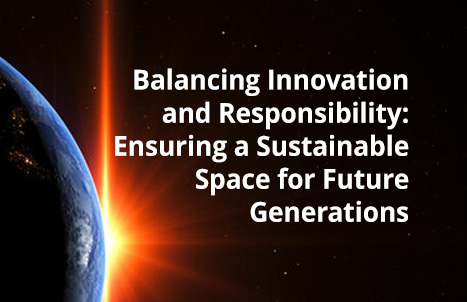Balancing Innovation and Responsibility: Ensuring a Sustainable Space for Future Generations
As humanity embarks on an ambitious journey into the cosmos, the need for sustainable practices in space exploration becomes increasingly critical. Shelli Brunswick, an accomplished motivational speaker, author, and futurist, brings over 35 years of experience in the aerospace and space industry to the forefront of this conversation. She started her distinguished career in the U.S. Air Force, focusing on space acquisition and serving as a congressional liaison to the US House of Representatives. Brunswick later was the Chief Operating Officer at Space Foundation, developing strategic initiatives to enhance global engagement within the space ecosystem. As the CEO and Founder of SB Global LLC, she champions integrating space technologies to address pressing global challenges, fostering collaboration across commercial, governmental, and educational sectors.
In her upcoming book, What’s Space Got To Do With It? 10 Life Lessons for Personal Growth, Brunswick draws insights from 30 global thought leaders, illustrating how the lessons learned from space exploration can inspire personal and professional development. She continues to share her passion for space innovation, empowering individuals to think beyond the horizon.
In a recent interview, Brunswick shares her perspectives on ensuring space remains a shared and secure domain for future generations as well the transformative potential of Earth Observation technologies in combating climate change and other critical issues. She also discussed how Canada can play a vital role in global space sustainability efforts
As a former U.S. Air Force legislative liaison, you engaged congressional staffers on the critical issue of space debris, bringing attention to its implications for future space missions. Today, you continue to be a vocal advocate for sustainable space practices. How serious is the challenge of space debris, and how can we effectively balance the pursuit of technological advancements in space exploration with the imperative to maintain a sustainable and secure environment for future generations?
Space debris, or “space junk,” has become one of the most pressing issues in modern space exploration, and I’ve seen firsthand how deeply it impacts the future of our missions. This critical problem, which includes everything from inactive satellites to fragments of past collisions, threatens to transform once-usable orbital paths into hazardous zones. Over 27,000 objects about the size of a softball or larger orbit Earth, and countless smaller fragments travel at extreme velocities, making each a potential hazard. Even the smallest piece can cause significant damage upon impact, setting off a chain reaction that leads to even more debris – a situation called the “Kessler Syndrome”.
In a recent Forbes Technology Council article, I discussed the urgent need for a sustainable approach to space, based on the three principles of “Reduce, Reuse, and Remove.” These principles, typically applied to environmental sustainability on Earth, are equally vital in managing our orbital environment.
The first step, Reduce, focuses on minimizing the creation of new debris. Reusable launch vehicles, like those developed by SpaceX and Blue Origin, reduce waste with each launch. Similarly, NASA’s National Orbital Debris R&D Plan aims to establish sustainable practices at every stage of a mission, from launch to re-entry. We can drastically reduce the risk of adding to the debris cloud by prioritizing reusable technology and sustainable mission design.
Then there’s Reuse – a concept now taking shape in orbit. Innovations in the commercial space industry are advancing in-orbit servicing technologies that can extend the lifespan of satellites through refueling and repair. It’s a powerful step forward. Not only does this reduce the need for new satellites, but it also creates a circular economy in space where resources are maximized rather than discarded. The European Space Agency’s (ESA) Clean Space initiative is even developing modular satellites, which allow for easier repair and replacement of parts, further reducing the potential for debris creation.
Finally, Remove is perhaps the most complex, as it requires a global commitment to actively clean up existing debris. Spacefaring nations are beginning to coordinate removal efforts through the support of organizations like the United Nations Office for Outer Space Affairs (UNOOSA) and the World Economic Forum. New technologies are being developed that target and deorbit large debris, clearing a path for safer space exploration. These efforts testify to the collaborative spirit needed to tackle this global challenge.
As we continue to explore and expand into space, a sustainable approach is not just necessary but foundational to future missions. Our progress in space hinges on our ability to respect and preserve this shared environment, ensuring that space remains safe and accessible for future generations.
How can we maintain space as a domain for peaceful exploration and ensure it benefits all nations?
The United Nations Committee on the Peaceful Uses of Outer Space (COPUOS) plays a pivotal role in shaping international space policy, ensuring that outer space remains a domain for peaceful exploration and sustainable development. COPUOS has long been committed to maintaining space as a shared resource that benefits all nations, regardless of their economic or technological status. Key to this mission is the “Long-term Sustainability of Outer Space Activities” guidelines, which promote responsible space practices, transparency, and international cooperation.
With the growing number of commercial space missions and increased satellite deployments, the need for sustainable space practices is more critical than ever. These practices align with the broader goals of sustainability that are essential for preserving space for future generations. Recent global conversations, including the 18th Sustainable Development Goal (SDG) roundtable event, have emphasized the importance of these principles. At this event, the panel on “Sustainable Space Development and Space for Sustainability” highlighted the role of civilian-led initiatives in fostering responsible space development while addressing environmental and economic sustainability challenges.
A central theme of the roundtable was COPUOS’s alignment with the Space2030 Agenda, a UN initiative aiming to ensure space activities contribute to the Sustainable Development Goals (SDGs) and global development. The Space2030 Agenda seeks to harness space technology to address critical challenges on Earth, such as climate action, economic growth, and sustainable resource management. The agenda emphasizes international cooperation, innovation, and the development of robust space policies to ensure space remains accessible and beneficial for all.
The 1967 Outer Space Treaty, developed by COPUOS, remains foundational in promoting peace in space, but new challenges, such as space mining and commercialization, call for updates to regulatory frameworks. The committee’s work provides an opportunity to develop equitable policies that prevent monopolizing space resources while encouraging their responsible use.
International collaboration is essential for achieving space sustainability. The International Space Station (ISS) exemplifies peaceful cooperation among nations, advancing science and technology for the benefit of all. Similarly, the Artemis Accords set norms for lunar exploration and encourage transparency. Collaborative efforts like those between the European Space Agency (ESA) and the United Nations Office for Outer Space Affairs (UNOOSA) demonstrate how international partnerships can address global challenges through space innovation.
COPUOS’s mission, bolstered by the Space2030 Agenda and key treaties like the Outer Space Treaty, underscores a global commitment to peaceful, sustainable, and inclusive space exploration. Through events like the 18th SDG roundtable, the international space community continues to foster collaborative efforts that address emerging challenges, ensuring that space remains an accessible and shared domain that benefits all humanity.
What are some of the most recent innovations in space technology and Earth Observation that you find exciting, and how are they transforming our approach to monitoring and understanding our planet?
Recent innovations in space technology and Earth Observation dramatically advance our understanding of environmental issues and support critical climate change response efforts.
One groundbreaking area is high-resolution satellite imagery from private constellations which provide daily images of the Earth’s surface. This frequent data allows for the rapid detection of environmental changes, urban expansion, deforestation, and natural disasters, offering real-time, actionable information that supports environmental response and resilience efforts.
Synthetic Aperture Radar (SAR) is another technology revolutionizing the Earth Observation field by capturing images through clouds and in darkness, essential for monitoring isolated or cloudy regions. This capacity enables precise tracking of polar ice, ocean oil spills, and potential geohazards, which are increasingly significant in understanding climate-induced risks.
Another transformative tool is hyperspectral imaging, equipped on satellites for monitoring detailed ecological data such as vegetation health, water quality, and atmospheric composition. This technology plays a vital role in agriculture, biodiversity conservation, and pollution management by providing data to assess crop vitality, detect invasive species, and identify pollution sources.
Smaller, affordable cubesats and nanosatellites have broadened access to space, allowing universities, research institutions, and smaller nations to conduct Earth Observation missions. These satellites are customized for specific needs, such as climate monitoring, and contribute valuable data for global environmental research.
AI and machine learning also amplify the power of Earth Observation data. AI-driven models have become increasingly integral to detecting environmental changes, modeling climate systems, predicting weather patterns, and accelerating data processing to support timely responses. AI-based tools are instrumental in tracking deforestation, forecasting natural disasters, and enhancing environmental policies.
These innovations contribute significantly to climate action by enabling more precise carbon tracking, supporting early warning systems for wildfires and ice sheet collapse, improving agricultural sustainability, and mapping urban heat islands to reduce energy use. Integrating advanced satellite technology with AI allows for a more proactive approach to climate resilience, a topic further explored in the full United Nations General Assembly (UNGA79) Science Summit, where panelists shared strategies and real-world applications for leveraging these space-based innovations.
Given Canada’s growing role in space exploration and technology, what opportunities do you see for Canadian contributions to global space sustainability efforts?
Canada’s expanding role in space exploration and technology presents unique opportunities for impactful contributions to global space sustainability. In an article in SpaceNews, I highlighted how Canada’s expertise – particularly in space robotics, medicine, and Earth Observation – positions it as a vital partner in the international space community. With its longstanding commitments, Canada is poised to lead in ensuring that space remains sustainable and accessible for all nations.
One of Canada’s strongest contributions lies in space robotics. Known for the Canadarm series, which has been critical to missions like the International Space Station and the upcoming Lunar Gateway. Lunar Gateway is a planned space station orbiting the Moon, supporting long-term lunar exploration and future deep space missions. Canada’s innovation in robotic systems could extend to active debris removal, on-orbit servicing, and other initiatives critical to maintaining a sustainable space environment. The upcoming Canadarm3, for example, leverages AI and advanced robotics to support long-term lunar exploration while showcasing sustainable practices that could be applied across various space missions.
Earth Observation is another area where Canada excels. The Canadian Space Agency’s (CSA) investments in Earth monitoring satellites, such as RADARSAT, provide invaluable data for tracking environmental changes, land use, and disaster management. These capabilities align with global sustainability efforts and contribute to addressing climate change by providing critical insights and data for informed decision-making.
In line with its tradition of multilateralism, Canada is also positioned to shape international space policy. Its participation in the Artemis Accords and active role in the United Nations Committee on the Peaceful Uses of Outer Space (COPUOS) demonstrate a commitment to fostering peaceful, cooperative norms. By advocating for clear frameworks governing sustainable resource utilization, Canada can ensure that space remains a shared and equitable domain, safeguarding against monopolization by a few powerful entities.
Canada’s emphasis on collaborative initiatives further underscores its potential as a leader in global space sustainability. From partnerships on the ISS to defense collaborations like the Five Eyes alliance, Canada’s diplomatic and technical networks serve as models for building cooperation in space. As space traffic grows and new actors join, Canada’s leadership in promoting transparency and peaceful collaboration will be vital for a sustainable space future.
Canada’s contributions in robotics, Earth Observation, and international collaboration make it a cornerstone of global space sustainability efforts. By leveraging its strengths and partnerships, Canada can help ensure that space remains a peaceful, accessible, and sustainable frontier for future generations.











